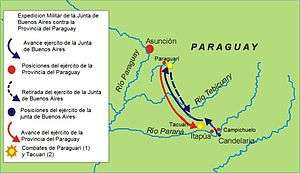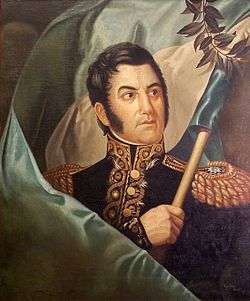Paraguay campaign
| Paraguay Campaign | |||||||
|---|---|---|---|---|---|---|---|
| Part of Spanish American wars of independence | |||||||
 The Argentine armies crossing the Paraná river | |||||||
| |||||||
| Belligerents | |||||||
|
|
| ||||||
| Commanders and leaders | |||||||
|
|
| ||||||
| Strength | |||||||
| Around 1,000 - 2,000 men [2] |
Spanish Troops: around 1,500 men | ||||||
| Casualties and losses | |||||||
| Around 500 - 1,000 men (killed, wounded and prisoners) | Around 500 - 1,000 men (killed, wounded and prisoners) | ||||||
The Paraguay campaign (1810–1811) was the attempt by a Buenos Aires-sponsored militia, commanded by Manuel Belgrano, to win the royalist Intendency of Paraguay for the cause of May Revolution. In Paraguay it is considered as their War of Independence.[3] The first battles fought were Battle of Campichuelo and Battle of Campo Maracana when Argentinians claimed victory. However, they were completely vanquished in the subsequent Battle of Paraguarí and Battle of Tacuarí. The campaign ended in a military failure and Paraguay broke its links with the Spanish crown just two months after Belgrano's withdrawal, starting its course towards full independence.
Actions of "la Primera Junta"
Three months after the creation of the Primera Junta, Manuel Belgrano was appointed Chief Commander of an army destined to gather support at Corrientes, Santa Fe, Paraguay and the Banda Oriental territories. Few days later his goal is made more specific: he must aim for Paraguay. The Junta had been informed that the patriotic party was strong there, and a small army would suffice to take control.[4] Trusting such information, Belgrano moved towards Paraguay with two possible goals, to guarantee a loyalty for the Junta in Paraguay or promote a new government that would stay in friendly terms with Buenos Aires.
Belgrano headed for the north with nearly two hundred men, expecting to gather more soldiers on his way to the Paraná River. Soldiers from the Blandengues regiments of San Nicolás and Santa Fe did join him en route, and later the Junta sent reinforcements of another two hundred soldiers. The army was welcomed by most of the population found in their way, receiving donations and new recruits in most villages. Finally, the small army grew to nearly 950 men, consisting of infantry and cavalry, divided in four divisions with one piece of artillery each.[5]
The Paraguayan Congress of July 24th, 1810
"This Congress will not discuss whether it's the sodomite King (of Spain) or his weak son, our ruler. None of them have anymore power upon Paraguay. This Congress must discuss the way of protecting our independence from Brasil, Buenos Aires and Lima... Paraguay is free, is independent and it is a Republic..."— Jose Gaspar Rodriguez de Francia, phD. Speech in the Paraguayan Congress of July 24th, 1810, according to F. Francisco Xavier de Bogarin.[6]
The remote Paraguay was a rather isolated region of Viceroyalty of the Río de la Plata, which made the ideas of regional independence stronger than in other provinces of the Viceroyalty.[7] The road to Paraguayan independence starts at the Congress of July 24, 1810 which was called by the last colonial governor to express province's loyalty to the Spanish crown. Paraguayans indeed refused to pledge themselves to the Primera Junta of Buenos Aires and agreed to remain loyal to the King of Spain. Yet, the process of independence started here, as many Paraguayans, led by José Gaspar Rodríguez de Francia and other patriots, took control of the situation and started working for obtaining independence, both from the United Provinces of the Rio de la Plata and the Kingdom of Spain.[8]
Belgrano ignored all this when he invaded Paraguay, believing that he would find a favourable political situation.[4] There were three main political tendencies in Paraguay: those who supported the Spanish Regency Council, those who supported the Junta of Buenos Aires, and those who supported independence.
The Campaign


By the end of October Belgrano's army stopped at Curuzú Cuatiá, where an old border conflict between Corrientes and Yapeyu was solved. Belgrano set the territories that would belong to Curuzu Cuatiá and Mandisoví, and organized their urban layout around the chapel and the school. By November 1810 the army reached the Paraná River near the Apipé island, and there Belgrano took measures to benefit the natives that were living in missions. With his authority as representative of Junta he gave them full civil and political rights, granted lands, authorized commerce with the United Provinces, and lifted the inability to take public or religious office. However, the Junta later requested him to seek authorization for such changes in the future.[9]
From that point the army moved to Candelaria, which is used as stronghold for the attack on Paraguay. The terrain gave a clear advantage to Velazco's Paraguayan troops who confronted Belgrano: the Paraná River, nearly 1,000 m. wide, was an effective natural barrier, and once it was crossed the Argentine army would have to move for a long distance across a land without supplies. Swamps, hills, rivers and lakes would also force the army to march slowly, making a possible retreat very difficult. The Parana was crossed with several boats on December 19, and a force of 54 Paraguayan soldiers was forced to flee during the battle of Campichuelo.
Belgrano saw Velazco's army from the Mbaé hill, and despite being greatly outnumbered he ordered the attack anyway, trusting in the moral strength of his soldiers.[10] When the battle of Paraguarí started, Belgrano's troops had an initial advantage, but eventually Velazco made his numeric superiority prevail, thanks to the intervention of the Paraguayan patriots (around 3,500 men, who completely outnumbered the forces of the Argentine general). Even with 10 deaths and 120 soldiers taken prisoner, Belgrano wanted to keep on fighting, but his officers convinced him to retreat. Belgrano's decision of continuing the fight wasn't based on foolish impressions, but in a very logical criteria about the superiority of his weapons because he knew that the Paraguayans were barely armed while his soldiers had full equipment and supplies.[11]
The army left for Tacuarí, being closely watched by the combined armies of Fulgencio Yegros and Manuel Atanasio Cabañas. Those two armies had nearly three thousand soldiers, while Belgrano was left with barely four hundred. They were attacked from many sides during the Battle of Tacuarí on March 9. Greatly outnumbered and losing an unequal fight, Belgrano was threatened with surrender, but refused to do so. He reorganized his remaining 235 men and ordered his secretary to burn all his documents and personal papers, to prevent them from falling into enemy hands. Belgrano arranged the troops and artillery to fire constantly, making the Paraguayan soldiers disperse. When the fire stopped, he requested an armistice, telling Cabañas that he had arrived in Paraguay to aid and not to conquer, but considering the open hostility he has found, he will leave the province. Cabañas accepted, on the condition that Paraguay was left within a day.[12]
Aftermath
The Paraguay campaign was a complete defeat for the Primera Junta from a military point of view. For the Paraguayans, the defeat of Belgrano became the independence from the rule of Buenos Aires and the launching pad for their liberty from the yoke of Spain. That's why both Paraguayans and Argentines consider that, despite the victory of Paraguay and the independence of the Intendencia del Paraguay from Buenos Aires, the actions of Belgrano were very important for the decisive Paraguayan independence from Spain. However, in doing so they also broke up with Buenos Aires: they maintained good relations, but were no longer part of the same political entity.
See also
Bibliography
- Luna, Félix (2004). Grandes protagonistas de la Historia Argentina: Manuel Belgrano (in Spanish). Buenos Aires: Grupo Editorial Planeta. ISBN 950-49-1247-8.
- García Mellid, Atilio (1964). Proceso a los Falsificadores de la Historia del Paraguay, Volumen I (in Spanish). Buenos Aires: Ediciones Theoria.
- Thompson, George (1869). The War in Paraguay. With a historical sketch of the country and its people and notes upon the military engineering of the war. London: Longmans, Green and Co.
- Bray, Arturo (1954). Hombres y Epocas del Paraguay, Primer Volúmen (in Spanish). Asuncion: Ediciones Niza.
- Mitre, Bartolomé (2011). Historia de Belgrano y la Independencia Argentina, Dos Volúmenes (in Spanish and English). U.S.: Nabu Press. ISBN 9781247596389.
- Vittone, Luis (1976). Dos Siglos de Política Nacional (in Spanish). Asunción: Imprenta Militar.
- Moreno, Fulgencio R. (1926). Estudios sobre la Independencia del Paraguay, Volumen I (in Spanish). Asunción: Ediciones América.






